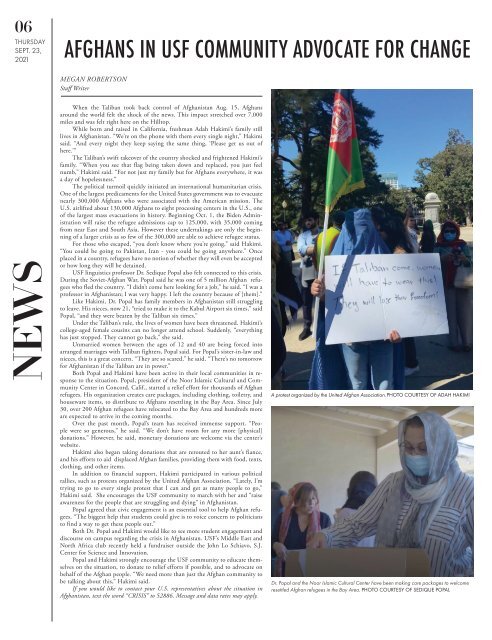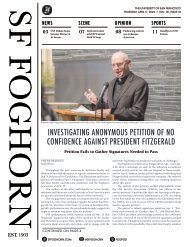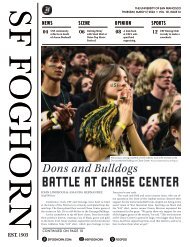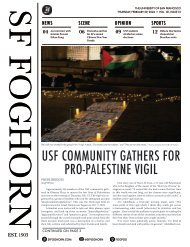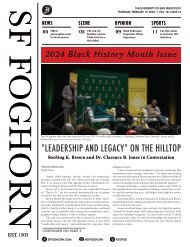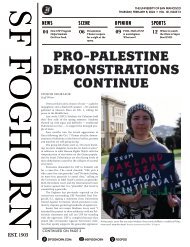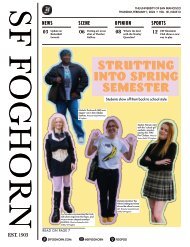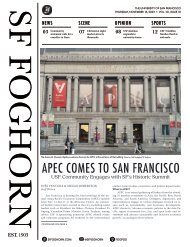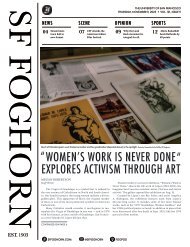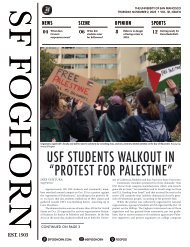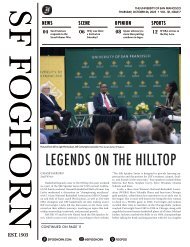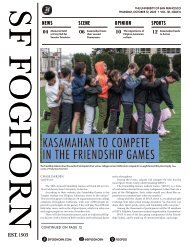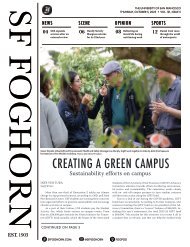Create successful ePaper yourself
Turn your PDF publications into a flip-book with our unique Google optimized e-Paper software.
06<br />
THURSDAY<br />
SEPT. <strong>23</strong>,<br />
<strong>2021</strong><br />
NEWS<br />
AFGHANS IN USF COMMUNITY ADVOCATE FOR CHANGE<br />
MEGAN ROBERTSON<br />
Staff Writer<br />
When the Taliban took back control of Afghanistan Aug. 15, Afghans<br />
around the world felt the shock of the news. This impact stretched over 7,000<br />
miles and was felt right here on the Hilltop.<br />
While born and raised in California, freshman Adah Hakimi’s family still<br />
lives in Afghanistan. “We’re on the phone with them every single night,” Hakimi<br />
said. “And every night they keep saying the same thing, ‘Please get us out of<br />
here.’”<br />
The Taliban’s swift takeover of the country shocked and frightened Hakimi’s<br />
family. “When you see that flag being taken down and replaced, you just feel<br />
numb,” Hakimi said. “For not just my family but for Afghans everywhere, it was<br />
a day of hopelessness.”<br />
The political turmoil quickly initiated an international humanitarian crisis.<br />
One of the largest predicaments for the United States government was to evacuate<br />
nearly 300,000 Afghans who were associated with the American mission. The<br />
U.S. airlifted about 130,000 Afghans to eight processing centers in the U.S., one<br />
of the largest mass evacuations in history. Beginning Oct. 1, the Biden Administration<br />
will raise the refugee admissions cap to 125,000, with 35,000 coming<br />
from near East and South Asia. However these undertakings are only the beginning<br />
of a larger crisis as so few of the 300,000 are able to achieve refugee status.<br />
For those who escaped, “you don’t know where you’re going,” said Hakimi.<br />
“You could be going to Pakistan, Iran - you could be going anywhere.” Once<br />
placed in a country, refugees have no notion of whether they will even be accepted<br />
or how long they will be detained.<br />
USF linguistics professor Dr. Sedique Popal also felt connected to this crisis.<br />
During the Soviet-Afghan War, Popal said he was one of 5 million Afghan refugees<br />
who fled the country. “I didn’t come here looking for a job,” he said. “I was a<br />
professor in Afghanistan; I was very happy. I left the country because of [them].”<br />
Like Hakimi, Dr. Popal has family members in Afghanistan still struggling<br />
to leave. His nieces, now 21, “tried to make it to the Kabul Airport six times,” said<br />
Popal, “and they were beaten by the Taliban six times.”<br />
Under the Taliban’s rule, the lives of women have been threatened. Hakimi’s<br />
college-aged female cousins can no longer attend school. Suddenly, “everything<br />
has just stopped. They cannot go back,” she said.<br />
Unmarried women between the ages of 12 and 40 are being forced into<br />
arranged marriages with Taliban fighters, Popal said. For Popal’s sister-in-law and<br />
nieces, this is a great concern. “They are so scared,” he said. “There’s no tomorrow<br />
for Afghanistan if the Taliban are in power.”<br />
Both Popal and Hakimi have been active in their local communities in response<br />
to the situation. Popal, president of the Noor Islamic Cultural and Community<br />
Center in Concord, Calif., started a relief effort for thousands of Afghan<br />
refugees. His organization creates care packages, including clothing, toiletry, and<br />
houseware items, to distribute to Afghans resettling in the Bay Area. Since July<br />
30, over 200 Afghan refugees have relocated to the Bay Area and hundreds more<br />
are expected to arrive in the coming months.<br />
Over the past month, Popal’s team has received immense support. “People<br />
were so generous,” he said. “We don’t have room for any more [physical]<br />
donations.” However, he said, monetary donations are welcome via the center’s<br />
website.<br />
Hakimi also began taking donations that are rerouted to her aunt’s fiance,<br />
and his efforts to aid displaced Afghan families, providing them with food, tents,<br />
clothing, and other items.<br />
In addition to financial support, Hakimi participated in various political<br />
rallies, such as protests organized by the United Afghan Association. “Lately, I’m<br />
trying to go to every single protest that I can and get as many people to go,”<br />
Hakimi said. She encourages the USF community to march with her and “raise<br />
awareness for the people that are struggling and dying” in Afghanistan.<br />
Popal agreed that civic engagement is an essential tool to help Afghan refugees.<br />
“The biggest help that students could give is to voice concern to politicians<br />
to find a way to get these people out.”<br />
Both Dr. Popal and Hakimi would like to see more student engagement and<br />
discourse on campus regarding the crisis in Afghanistan. USF’s Middle East and<br />
North Africa club recently held a fundraiser outside the John Lo Schiavo, S.J.<br />
Center for Science and Innovation.<br />
Popal and Hakimi strongly encourage the USF community to educate themselves<br />
on the situation, to donate to relief efforts if possible, and to advocate on<br />
behalf of the Afghan people. “We need more than just the Afghan community to<br />
be talking about this,” Hakimi said.<br />
If you would like to contact your U.S. representatives about the situation in<br />
Afghanistan, text the word “CRISIS” to 52886. Message and data rates may apply.<br />
A protest organized by the United Afghan Association. PHOTO COURTESY OF ADAH HAKIMI<br />
Dr. Popal and the Noor Islamic Cultural Center have been making care packages to welcome<br />
resettled Afghan refugees in the Bay Area. PHOTO COURTESY OF SEDIQUE POPAL<br />
CALLIE FAUSEY<br />
Staff Writer<br />
MCCARTHY CENTER MURAL ILLUSTRATES<br />
PATHWAYS TO A BETTER FUTURE<br />
The Leo T. McCarthy Center for Public Service and the Common Good<br />
(LTMC) unveiled a new mural this week that encapsulates the center’s mission<br />
and values by bringing together historical imagery and symbolism alluding to<br />
a brighter future. Although USF and its students are not unfamiliar with some<br />
of the murals decorating the city, the piece will be the first large-scale mural<br />
project seen at USF in several years.<br />
The design committee, which was made up of LTMC students, community<br />
partners, staff and faculty, prompted the question: “Imagine waking up<br />
tomorrow to a re-imagined, just world. What does it look like?”<br />
For senior Priana Aquino, a public service and community engagement<br />
minor through one of the center’s programs, being on the committee was exciting.<br />
“Not only do I enjoy talking about art, I was able to be around a group of<br />
people from USF for the first time in a year and a half,” Aquino said. “The idea<br />
of community, specifically bridging community, was important to me. As we<br />
come into a new kind of pandemic life, I wanted to reflect in our mural how<br />
our concepts of community will remain the same no matter how isolated we<br />
are from each other.”<br />
LTMC partnered with Precita Eyes Muralists, a local mural arts organization<br />
and artist collective, to assist in bringing their ideas to life. After brainstorming<br />
various themes and multiple individual design drafts, the process revealed<br />
a combined “vision of different pathways all leading to a path toward<br />
equity that we are all traveling,” according to the center’s website.<br />
Derick Brown, the senior director of the McCarthy Center, said the mural<br />
captures the LTMC’s primary goal of preparing students for a successful life in<br />
public service and the center’s emphasis on connecting USF to the broader San<br />
Francisco community.<br />
“We’re the heartbeat of USF,” said Brown. “When I look at the mural, it<br />
really showcases the center, and what we stand for, what we believe in, some of<br />
the work that we have been doing but then also what we hope for the future.”<br />
The mural’s narrative according to the LTMC’s Director of External Relations,<br />
Leslie Lombre, begins with “Native Ohlone patterns that point up to<br />
Muralist Francisco Franco repaints the sky around the sun to highlight its rays. PHOTO BY CALLIE FAUSEY / SAN FRANCISCO FOGHORN<br />
the night sky and the Golden Gate Bridge with an ominous glow of the moon<br />
upon the fog, this representing the unknown or the lack of clarity that we all<br />
have when beginning a journey.”<br />
The viewer’s eye follows this journey from the foggy night sky to the Civic<br />
Center lit up in a rainbow. Pouring out of the building is a peace parade made<br />
up of a “rainbow of people” from all walks of life advocating for revolutionary<br />
love.<br />
The parade was one of muralist Francisco Franco’s favorite components of<br />
the overall design. Franco described his work with Precita Eyes and LTMC as a<br />
collaborative effort. His job was to take inspiration from the committee's ideas,<br />
stitch them into a cohesive story, and make it visual.<br />
“Creating a composition with all their ideas was the hard part,” said Franco<br />
while taking a break from repainting the mural’s sun on <strong>Sept</strong>. 14. Despite<br />
the challenges that arose, Franco ended up with a final design that he called<br />
“Bay-Area-esque.” Franco said that the Bay Area tradition of making a difference<br />
through grassroots efforts and community education, as depicted in the<br />
mural, relates to how he got to where he is now as a self-taught artist.<br />
The mural’s parade passes by a “tree of wisdom” filled with books and<br />
reaching out in all directions. The tree also features a Black Panther to represent<br />
“the Bay Area’s history of Social Justice movements and its fierce and powerful<br />
influence for change.”<br />
“There's gonna be a lot of roots coming down from the tree, to represent<br />
native roots, and also people who come here and set roots down to make the<br />
Bay a more beautiful and just community,” said Franco.<br />
One of the last additions to the piece were jazz players who represent<br />
the Fillmore’s musical history and invite the crowd to “go off the beaten path,<br />
which is necessary to create change and in discovering new frontiers.” Many<br />
pathways are featured in the mural, all leading into the light of a shining sun.<br />
The sunrays represent enlightenment and success.<br />
“Sometimes you have to go out there to stand for what you believe in, and<br />
that's depicted in the mural, but it's also what we're teaching the students day<br />
in and day out,” said Brown.<br />
Aquino also said that the mural represents everything the McCarthy Center<br />
stands for. “Everything we work for is done for those who came before us<br />
and those who will come after us, fortifying a legacy of love that will pave the<br />
pathway to equality and prosperity.”<br />
07<br />
SCENE


